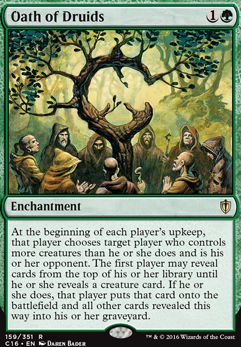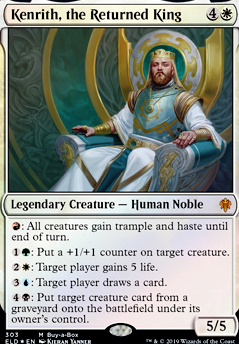Bring It All Back
Preface:
Although the end result of the combo will result in infinite mana, there are quite a few different combinations of cards that can execute the combo.
Requirements:
Any of the following combinations will result in infinite mana of every color:
- Second Sunrise in hand, Phyrexian Altar, Eternal Witness, and 3 other creatures in play.
- Second Sunrise in hand, Phyrexian Altar, Lotus Petal, Eternal Witness, and 2 other creatures in play.
- Second Sunrise in hand, Phyrexian Altar, Eternal Witness, and Squandered Resources in play.
- Second Sunrise in hand, Phyrexian Altar, Eternal Witness, and Zuran Orb in play.
Alternatively, the combo is possible with Faith's Reward:
- Faith's Reward in hand, Phyrexian Altar, Eternal Witness, and 4 other creatures in play.
- Faith's Reward in hand, Phyrexian Altar, Lotus Petal, Eternal Witness, and 3 other creatures in play.
- Faith's Reward in hand, Phyrexian Altar, Eternal Witness, and Squandered Resources in play.
- Faith's Reward in hand, Phyrexian Altar, Eternal Witness, and Zuran Orb in play.
Procedure:
- Sacrifice creatures to Phyrexian Altar, making sure to add . The color of the rest of the mana you add doesn't matter.
- Cast Second Sunrise, returning all cards that hit the graveyard.
- Eternal Witness ETB trigger, targeting Second Sunrise, returning it to your hand.
After completing steps 1 through 3, we are left with the same board state we started with, but with one mana of any color in our mana pool. Repeating the loop a artibrarily large amount of times, we achieve infinite mana.
Winning
With infinite mana achieved, we cast our general, Kenrith and can use his abilities to win the game:
- Infinitely pump our creatures, give them trample and haste, and swing for lethal.
This is usually the first way to try to win the game, as it gets around infinite life via Commander damage. If our opponents try to disrupt, we can use the other 2 options to win in response.
- Put a very large amount of Draw abilities on the stack, targeting each opponent.
We can respond to anything our opponents cast by putting another very large amount of Draw abilities on the stack, repeating as necessary for each spell cast.
- Sacrificing and recurring Eternal Witness, to infinitely cast every spell in our graveyard.
This part isn't necessary unless there are multiple permants that pose a problem to winning via our Commander's abilities. Addtionally, we can grant ourselves infinite 2/2s.
Caveats
For the combos using only one creature and either Squandered Resources or Zuran Orb, you will need lands that produce different colors of mana to achieve infinite mana of each color. This means that the colors of mana the lands produce dictates what victory route(s) you have to take.
With Aetherflux Reservoir in play, we don't need to net mana to get the kill as we are casting many, many spells.
This combo can be performed without netting mana and a win condition and still be beneficial. For instance, if one of the other creatures being recurred is Sun Titan, we get to bring back each permanent with CMC 3 of less from our graveyard. If any of those permanents are fetch lands, we can thin our deck of all the lands they can search for, thereby ramping us. This line of play might be worth while if we have a very juicy graveyard or if we need to respond to our graveyard being exiled.
Yup, Artifacts Are Still Dumb
Preface:
A more common combo in EDH, but has synergy with our top deck manipulation suite. Turns out, when you start out at 40 life,
Bolas's Citadel is an even better card.
Requirements:
Any of the following combinations will result in achieving the combo:
- Bolas's Citadel, Aetherflux Reservoir, and Sensei's Divining Top in play.
- Bolas's Citadel and Aetherflux Reservoir in play, Sensei's Divining Top on top of the deck.
- Bolas's Citadel and Sensei's Divining Top in play, Aetherflux Reservoir on top of the deck.
Procedure:
- Sensei's Divining Top to draw a card, putting Sensei's Divning Top on top of the deck.
- Play Sensei's Divining Top from the top of the deck using Bolas's Citadel, losing 1 life.
- Trigger and resolve Aetherflux Reservoir's ability gaining X life, where X > 1.
After completing steps 1 through 3, we are left with the same board state we started with, but with at least 1 spell cast this turn. Repeat this process enough times to gain a large amount of life and play the entire deck.
Winning
With enough life to activate Aetherflux Reservoirs ability, we can dome each opponent for 50 points of damage. This combo is not an infinite, as you will eventually deck yourself. To make it a true infinite, you have three options:
- Be able to cast Entomb with Gaea's Blessing still in the deck to refill the deck.
- Have Abundance in play.
- Have Underrealm Lich in play.
Option 1 is very unlikely, especially multiple times in a row, but is an option nonetheless. Getting Option 2 or 3 is much more feasible, since we are drawing/playing through the entire deck. Both
Abundance and
Underrealm Lich are replacement effects, so we never actually draw any cards when using it, and therefore never actually deck out when comboing off. With this, we can achieve infinite life and infinite damage.
Other Combos
Apptly named "CounterTop", this combo allows us to maintain a controlling grip on the game state. When an opponent casts a spell, Counterbalance will trigger. In response to that trigger, we activate either Top or Scroll Rack to put a card with a matching CMC on top of our deck so that when Counterbalance's trigger resolves, it will reveal the matching CMC card and counter the spell. This combo is very sustainable in that Top doesn't tap when looking at the top 3 cards. Scroll Rack does tap, and therefore is not sustainable over the course of a full round, but does let us put cards from our hand to the top of the deck.
Other cards, such as the instant speed tutors, allow us to dictate the top card of our deck, in case we don't see the correct CMC in the top 3 cards. Also, we run a number of instant speed shuffle effects that we can use to get another chance to counter the spell with the new top 3 of the deck. In a pinch, we can use our lands with activated abilities that recur different card types to put back the desired CMC card.
Vilis is our bomb creature and turns the downsides of cards into upsides. There are a total of 27 cards in the deck, not including Vilis himself, that can trigger his ability. With 27% of the deck having synergy with Vilis, there is a good chance you will have two or even three cards that will combo with him.
The Dream
There are certain cards that provide greater card advantage with their loss of life "downside": Sylvan Library, Bolas's Citadel, and Underrealm Lich. Each one being better than the last; with any of these cards, we can quickly draw almost the entire deck. Sylvan Library is limited to being in your draw step only. Bolas's Citadel is limited to the timing of whatever card is on top. Underrealm Lich is the ideal card to combo with Vilis in that you can activate the Lich's ability multiple times, at instant speed. Additionally, the Lich's static effect is a replacement effect, so we cannot lose to decking out.
I Hear Ancestral Recall is Good
Drawing 3 cards is what Ancestral Recall does and we can mimic that powerfull effect by cracking any of our fetchlands and searching up a shockland. Due to this, it is often best practice to search for twisties in the early game to keep our shocklands in the deck to be searched out when we get Vilis in play, even when we can afford for a land to come into play tapped.
Additionally, damage from a lost coin flip from Mana Crypt can turn into an Ancestral effect. The best practice is to declare that the Mana Crypt triggers first, followed by Oath, so that the Oath trigger resolves first and if we get Vilis and lose the Crypt trigger, we draw extra cards. It's wild that this list wants to lose a Mana Crypt trigger sometimes.
The Rest Is Just Gravy
Our painlands turn into card draw. Our tutors that lose us life become even better. Even how our opponents attack us changes with Vilis in play (spoiler: they don't attack, it's awesome). Ever wanted an opponent to keep a Cindervines in play? I have one game; drawing a card off of every non-creature spell is amazing. Worst case is that you have to target Vilis with his own activated ability to draw cards.




